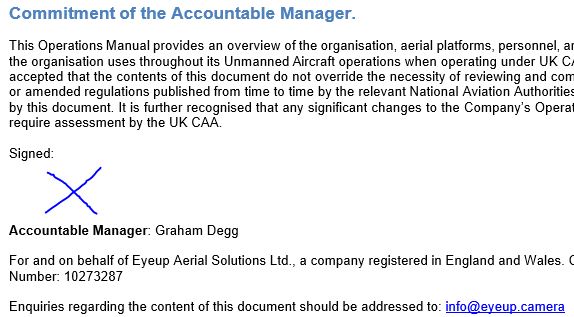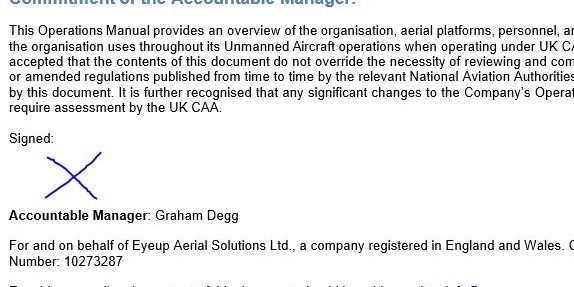
Accountable managers
Accountable Managers are common in aviation and it is a very responsible position.
If you hold a permission from the CAA, (commonly referred to as a PfCO), or a GVC (General VLOS Certificate), you’ll know all about the role of the Accountable Manager right?. That’s because every Operations Manual is signed by the Accountable Manager…and in a one-man enterprise, that’ll be you.
I’m sure your training organisation explained the role of the Accountable Manager in detail, however, looking at some manuals it appears that perhaps they thought you didn’t need to know, they thought it was self-explanatory or they didn’t understand the role themselves.
Yet another manager!
The trouble is that last year, the CAA was then driven by changes to the Air Navigation Order (ANO) to formalise the roles of SUA Operator and the Remote Pilot and pull them into the new registration scheme. These roles aren’t limited to commercial operations either as they also apply to hobby flyers where, for instance, a parent may act as the SUA Operator to manage flights by other family members. In this case, all members of the family who want to fly the drone would need to pass the DMARES online test and obtain a Flyer ID.
So, for commercial operators we have three roles to consider. The Accountable Manager, the SUA Operator and the Remote Pilot.
Many of you will be working for yourselves and may never intend to change this. Others though may have other ideas and want to work with other operators, perhaps joining to bring strengths together and create a bigger, more resilient company. If this is you, then you need to understand that the roles and responsibilities associated with the roles are very different. Not grasping this could leave you looking amateurish…for instance if you have a CAA audit booked and leave it to one of your Remote Pilots because they plan and undertake all the flights. There’s no reason why a pilot shouldn’t attend…but the CAA want to see the person who is accountable sitting in front of them and surprise, surprise, that’s the Accountable Manager.
Let’s break it down a bit
Accountable Manager
The Accountable Manager is the head honcho, the grand fromage of the organisation. The person taking on this role must ensure that sufficient finance is in place to operate safely, that there is a safe system of work in place (the Operations Manual and associated processes) and that appropriate nominated post holders are in place. While you’re about it, make sure that legal requirements such as insurances are in place. As mentioned above, it’s the Accountable Manager as a minimum, that the CAA will want to see during an audit.
SUA Operator
The SUA Operator is the new kid on the block. Introduced in the March 2019 amendment to the ANO, this is also a management role and despite the title it has nothing directly to do with operating a Small Unmanned Aircraft…I know, bizarre isn’t it? Where does the management role come in? Well, Article 94G b) states that “the “SUA operator”, in relation to a small unmanned aircraft, is the person who is responsible for the “management of the small unmanned aircraft.” The problem is that “management” in this definition isn’t defined in the ANO so we have to look elsewhere for clues as to what this role entails.
Fortunately, a few paragraphs up in the ANO, the responsibilities are laid out in black and white. You can find the relevant details in sections 94D and 94F if you feel like digging into some multiple sub-clauses but I’ll save you the trouble if you fancy a pint instead. Essentially the SUA Operator is responsible for:
Ensuring that the SUA under his/her control is not flown unless there is an appropriate registration in place. This manages to be both tortuous and tautological at the same time. After all, if there is no registration in place then there is no SUA Operator to ensure there is a registration in place! Glad that’s cleared up.
In short, the SUA Operator is tasked with ensuring that the PfCO Operator holds a valid certificate of registration.
It appears that the CAA is taking this aspect very seriously. Some operators seem to have submitted flight logs showing flights that took place after 30th November 2019 (when registration commenced) and a later date when the operator got around to registering. This seems unfair to professional operators who see themselves as being hit hard while illegal flyers seem to run rings around the authorities. However, note the word “professional” in that last sentence. PfCO holders want to be taken seriously by the CAA so we should act professionally and ensure we keep up with widely flagged rule changes. By the way, if you realise you’ve been flying after 30th November 2019 but before obtaining a SUA Operator ID, I would really advise being completely open with the CAA. The regulator works under a Just Culture and this requires openness. I have seen it suggested online that operators should falsify their records to avoid a problem but I really suspect that this would land you in extremely hot water with the regulator.
But it doesn’t end there. The SUA Operator is also tasked with ensuring that any flight it only carried out by an appropriately competent Remote Pilot. For PfCO holders this is currently very easy since until the 30th December 2020 there is still a general exemption in place, ORS4 1394, meaning that any remote pilot legitimately working under a PfCO is considered to be competent. After this date, all Remote Pilots will have to hold a current Flyer ID and have therefore passed the online DMARES test.
Oh yes, finally you get to ensure that there is a lovely sticker on each of the organisation’s drones to clearly display that precious SUA Operator ID, (note, not a Flyer ID). You don’t have to stick it on yourself, but you do have to ensure it has got there somehow.
So, without ever flicking a remote controller’s stick, you can be classed as an SUA Operator.
Remote Pilot
That leaves the Remote Pilot.
Easy you say, the Remote Pilot just flies the drone yes? Well, nearly. While the SUA Operator is responsible for ensuring the Remote Pilot is competent, the Remote Pilot has a reciprocal responsibility to ensure that the operator they are flying for holds a current, valid registration. They are also responsible for ensuring they hold their own Flyer ID (or that there is a general exemption in place that covers them as above. So if you are flying on another operators Operations Manual or OSC presumably you’ll be able to demonstrate to the CAA that you ensured the organisation you were flying for was properly registered?
Of course, a Remote Pilot is responsible for a whole bunch of additional stuff, with which you will already be familiar and which are absolutely critical to the safety of any flight, but this article only intends to cover the very specific responsibilities covered by last year’s changes.
Heeeeellllppppp! What goes into my Operations Manual?
I know from the many Operations Manuals I see that many operators don’t cover these responsibilities in full. The CAA seems to accept this, though they are tightening up on ensuring an appropriate SUA Operator is in place. The safest way to ensure this is to apply for a registration in your organisation’s name. But my personal view is that should not be essential. Your organisation must have a SUA Operator in post but this can be an individual associated with the business and importantly, specifically nominated as such. It obviously makes sense for this person to be as close as possible to the day-to-day operations in order that they are in a credible position to meet the responsibilities detailed above.
Finally, as your business grows, you may find yourself rather busy and want to have staff covering more roles. You could find yourself operating in safety critical industries where enhanced training is considered essential… so you end up with a training manager or administrator. Or you could be covering high volume projects where you need more Remote Pilots so you promote yourself to Chief Pilot. Sounds great, but what is that role? What does the Chief Pilot do that your regular Remote Pilots don’t? The important thing is that you recognise these roles as they emerge, define them and then build them into your organisation.
Need help?
On a growth path? Need to understand the legislation in detail better? Want to fly closer, further, higher than the competition but do it safely and with a full understanding of the risks?
Give Eyeup a shout and I’ll see how I can help or if I know somebody else who can.






